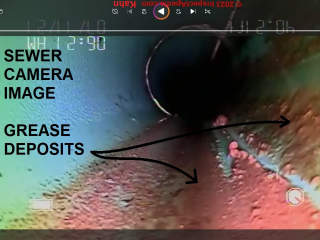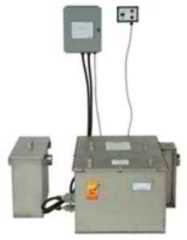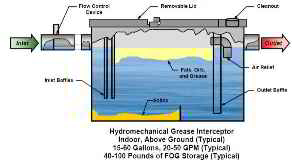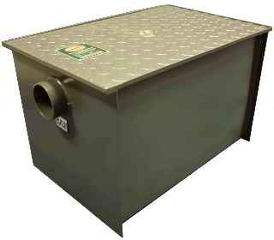 Grease Interceptors - Grease Traps
Grease Interceptors - Grease Traps
Grease trap types, specifications, sources, installation
- POST a QUESTION or COMMENT about the different types, installation & maintenance of grease interceptors or grease traps in buildings
Grease interceptors: this article describes the different types of grease interceptors or grease traps used to prevent drain & sewer system clogging by catching & permitting the removal of FOG (fats, oil, grease) from a building's plumbing system.
The article describes traditional gravity and baffle operated grease traps, hydromechanical grease traps, and automatic grease removal units or AGRUs. Sources for grease interceptor installation, specifications, maintenance, & building codes as well as producers & sources of these grease interceptor or grease trap products are included.
Page top photo: grease deposits in the bottom and on one side of a sewer line, revealed by a sewer line camera inspection. Excessive grease build-up in septic or sewer lines can lead to a costly drain blockage in piping and in a drainfield can speed soil clogging leading to drainfield failure. Photo courtesy of home inspector DovBer Kahn.
InspectAPedia tolerates no conflicts of interest. We have no relationship with advertisers, products, or services discussed at this website.
- Daniel Friedman, Publisher/Editor/Author - See WHO ARE WE?
Grease Trap Requirements & Installation Procedures
 Fats, oils, and grease that are poured down building drains cause serious clogs in normal drain traps, drain piping, sewer piping and even public sewers & pumping stations.
Fats, oils, and grease that are poured down building drains cause serious clogs in normal drain traps, drain piping, sewer piping and even public sewers & pumping stations.
Fats, oils and grease, referred to in plumbing trades as FOG have been cited for as causing more than sixty percent of public sewer backups in New York City, at an annual cost of $4.65 million in 2013. (Gregory, The New York Times, 2014).
Illustrated at left: Zurn's Z1192 Grease Recovery Appliance (see AGRU below).
[Click to enlarge any image]
Types of Grease Interceptors or "grease traps"
Grease traps separate fats, oils, and grease from wastewater using one of several methods:
- Automatic Grease Removal Units (AGRUs) use a combination of mechanical and electrical paddles or skimmers to remove nearly 100% of fats, oils and greases that pass through the AGRU. These grease separators are the most efficient of the three types discussed here as well as the smallest, but they cost more and are more complex in design, though Prima notes that they are low-maintenance and because of their small size, are easiest to install.
Watch out: some municipalities permit only AGRUs in new installations, and no longer permit passive style grease traps such as the gravity traps described just below. Quoting:
New or replacement grease trap installations shall be of the Automatic Grease Recovery Unit (AGRU) type. Passive style grease trap installations shall not be permitted.
Grease traps must have the NSF or Plumbing Drainage Institute certification. The minimum acceptable size is rated at 20 gpm / 40lbs.
All grease traps must be installed in accordance with the manufacturer’s specifications, which include the flow restrictor and venting prior to the discharge entering the grease trap. - (Murfreesboro 2014)
Photo above: a traditional baffle and gravity type grease interceptor produced by Atlantic Metal Works (formerly Prima Supply).
- Gravity operated grease traps use multiple compartments to slow the flow of wastewater to allow solids and grease to separate.
At higher temperature than the hydromechanical trap discussed next, in a gravity operated grease interceptor the FOGs float in the upper area of the trap where they are trapped by one or more baffled compartments; solids (grit, dirt) settle to the trap bottom.
Using the gravity method about 90% of FOGs can be removed from wastewater, but more space is required for these device than the more complex units described here.
Shown above: a gravity & baffle type grease trap produced by Atlantic Metal Works (formerly Prima Supply).
- Hydromechanical grease interceptors rely on a process of cooling wastewater to allow heavier FOG to settle to the trap bottom for collection and cleaning.
- The capacity of hydromechanical grease traps is rated in pounds (capacity) and flow rate (gallons per minute). For example Prima's hydromechanical grease traps are sized from 8#/4gpm up to 100#/50 gpm.
 Illustrated at left is a hydromechanical grease interceptor [Bay Area Pollution Prevention Group BAPPG (2011) who have publised a series of helpful documents listed below.]
Illustrated at left is a hydromechanical grease interceptor [Bay Area Pollution Prevention Group BAPPG (2011) who have publised a series of helpful documents listed below.]
An excellent explanation of grease traps or interceptors is provided by a guidance document provided by the Carrolton Tx. government (2012) from which we quote:
[Grease interceptors or fat oil & grease FOG] traps use the physical principal that fats, oils and grease are lighter than water and will rise to the top of a water surface and heavy debris will fall to the bottom of the trap when the mixture is allowed to stand for a period of time in quiet conditions.
The longer the wastewater stays in the trap, the better the separation. But as the amount of retained grease and solids increase, the effective volume of the trap decreases, retention time decreases and physical separation decreases, resulting in pass through of solids, fats, oils and grease.
To prevent this, grease traps and interceptors have to be regularly maintained by having a permitted liquid waste hauler remove both the top grease layer and the bottom solids.
FOG Grease Trap Size Requirements
The size required for a grease interceptor or grease trap is specified in the Uniform Plumbing Code (UPC). Typically local or municipal regulations indicate that grease trap size requirements depend of course on the volume of fats and oils passing into the drain system.
Typically municipal codes regulating grease interceptor installation give general guidelines such as light or heavy food preparation, and additional capacity guidelines are given by the grease trap manufacturer's installation specifications (referred-to below). Typically the grease interceptor capacity required is specified as one of three categories:
- None required: for facilities not engaged in food preparation
- Typical AGRU type specification: 40 pound capacity and 20 GPM minimum wastewater flow capacity.
- Light food preparation: 500-gallon grease interceptor with a minimum of two baffles
- Heavy food preparation: 1000-gallon or larger grease interceptor with at least two baffles
Grease Trap Cleaning & Maintenance Requirements
The cleaning frequency depends on grease interceptor size or capacity, type, wastewater flow, and local regulations.
For example, a community may specify that an AGRU must be "cleaned per the manufacturer's specifications", or that an existing (not permitted in new installations) passive style grease trap will be cleaned every two weeks, or at an interval specified by a local authority, or as follows:
If the FOG and food solid content of the grease trap is greater than 25%, then the grease trap must be cleaned every week, or as frequently as needed to prevent 25% of liquid capacity displaced by FOG and food solids (25 % Rule criterion).
Automatic Grease Recovery Unit (AGRU) style Grease Traps will be cleaned per the manufacturer’s recommendations, which typically includes FOG disposal and removal of food solids from the strainer basket on a daily basis and weekly maintenance of the skimming mechanism. - (Murfreesboro 2014)
Note: Additives, treatments, and enzymes are not required for grease traps and are prohibited in some municipalities. Quoting:
No additives (i.e. enzymes, bacteria, etc...) shall be added prior or directly to any chamber of the grease trap or any component of the plumbing connected to a grease control device. (Murfreesboro 2014) Also see SEPTIC TREATMENTS & CHEMICALS
Grease Trap Waste Disposal
The grease interceptor codes & specifications we reviewed were mostly silent on this topic, but those that did discuss grease disposal suggested bagging the grease or other trap or interceptor debris in heavy plastic garbage bags for disposal as food waste.
Speaking of disposing of grease interceptor waste reminds installers of the importance of making the grease interceptor easily accessible. A reader who asked us about installing a grease trap in a 25-foot deep manhole where a sump or ejector pump system was in use had perhaps not imagined the service person having to lug a 25 or 50 pound bag of grease waste up a ladder.
FOG Grease Trap Location Requirements
For a grease interceptor to work properly it must be located sufficiently far from the hot water source that the wastewater entering the trap will be cool enough that the trap can in fact do its job: trapping fats, oils and grease passing by. A grease trap must be accessible for regular inspection (through a wastewater sampling well) and cleaning.
The model code we cite below specifies the following:
Grease interceptors are to be installed at a distance of 8-10 meters from the last contributing fixture to allow for adequate cooling of the wastewater, while preventing grease solidification in the lines. Water temperatures must be less than 110 degrees Fahrenheit prior to entering grease trap.
Sample wells will have a 15” diameter access cover and a minimum 4” drop from inlet to outlet piping through the sampling well. Mechanical Grease Traps and Interceptors that are installed above ground must be equipped with an influent flow regulator and an effluent valve assembly that allows for sample collection. (Carrolton 2012)
Other Commercial Facility Plumbing Traps & Filters
Other commercial facilities are required to install FOG interceptors, debris and grit traps, or lint interceptors, such as automobile repair shops, car washes, and commercial laundries.
Automotive repair facilities are typically required to install a grit and oil trap and separator on their drain with a typical minimum capacity of 50 gallons for the first 100 sq. ft. of area drained (such as the garage floor) and an additional one cubic foot of capacity (7.5 gallons) per additional 100 sq .ft. of floor area.
Commercial laundries may be required to install suitable filters and traps also intended to protect the sewer system but designed to capture other clog-source materials such as lint traps. is specified in the Uniform Plumbing Code (UPC) Appendix H contains the formula for calculating a lint filter size for commercial facilities.
How are Grease Clogs Cleared?
In municipal and building plumbing systems when a grease-clogged drain line or sewer line are discovered to have been clogged by FOGs experts use high powerd vacuums or high pressure water to attempt to clear the drain. Simple mechanical drain cleaning that is used to clear more solid obstructions may be ineffective.
References & Sources for FOG Grease Interceptors & Traps, Codes, Specifications, Remedies
- "FOG Hydromechanical Grease Interceptor Fact Sheet", (2011) Bay Area Pollution Prevention Group (BAPPG), PO Box 24055, MS 59 Oakland, CA 94623 (925) 765-9616 (Tel) (510) 287-1351 (Fax) David Williams, executive directory, Email: dwilliams@bacwa.org, retrieved 2/14/2014, original source: http://bacwa.org/committees/ bay-area-pollution-prevention-group/documents
- "FOG Gravity Grease Interceptor Fact Sheet", (2010), BAPP, ref. cit., orignal source: http://bacwa.org/Portals/0/GGI%20Fact%20Sheet-Final.pdf
- "Restaurant Grease - Information Sheet: Avoid Fines and Health Risks from Grease Overflows - Grease Removal Devices", BAPPG (2011), ref. cit., http://bacwa.org/committees/bay-area-pollution-prevention-group/documents
- "(BAPPG) Fats, Oils & Grease - Lose Ten Pound Of Fat in One Day, by using an easy, one-stop fat drop off destination in your area", (2011) BAPPG, ref.cit., http://bacwa.org/committees/bay-area-pollution-prevention-group/documents
- "Guidance Document for Sizing and Installation of Grease Traps and Interceptors", Carrolton Texas, January 2012, retrieved 2/16/2014, original source: http://cityofcarrollton.com/Modules/ShowDocument.aspx?documentid=8181
- "Specifications for Grease Traps & Grease Interceptors", City of Columbia, retrieved 2/16/2014, original source: http://www.columbiasc.net/depts/utilities-engineering/docs/engregs/uefileueengregpart30.pdf
- "Grease Control Equipment Specifications", Murfreesboro, TN, retrieved 2/16/2014, original source: http://www.murfreesborotn.gov/DocumentCenter/View/504
- "Grease Interceptor Designs", Water Reclamation Division, Environmental Compliance Section (407) 254-7710, Environmental.Compliance@ocfl.net Orange County, FL, USA, retrieved 2/16/14, original source: www.orangecountyfl.net
- Uniform Plumbingt Code, Chapter 10, Traps and Interceptors, retrieved 2/16/14, original source: http://www.cbs.state.or.us/bcd/notices/Hearings/code/Ch_10.pdf - this chapter includes sizing charts for different types of grease interceptors
- Uniform Plumbing Code, Appendix H, Interceptor Sizing, retrieved 2/14/16, original source: http://www.co.maui.hi.us/documents/11/28/Grease%20Interceptor%20Appendix%20H%20Form.PDF
- "Plumbing Code in Commercial Kitchens", NH BOA (2012), retrieved 2/16/14, original source: http://www.nhboa.net/pdf_documents/PlumbingCodeinCommercialKitchens_5.9.12.pdf
Grease Interceptor Suppliers
- Ashland PolyTraps, Ashland Trap Distribution Company, POB 218, Williston OH 43468, Website: ashlandpolytraps.com, Tel: 1-800-541-8004 - USA
- Big Dipper
- Great Basin grease trap Model # GB-75 (suitable for light food preparation) or MOdel # GB-250 suitable for heavy food preparation
- Hanson Pipe & Pre_Cast grease traps, interceptors
- Old Castle Precast, Website: www.oldcastleprecast.com
- Park Environmental Equipment, Website: www.park-usa.com
- Prima Supply (restaurant equipment), Website: www.primasupply.com, Tel: 888-810-5043 - USA
- PW Eagle
- Schier Products, Website: www.shierproucrts.com
- Trapzilla grease trap Model No. TZ-600 (suitable for light food preparation), Website: www.trapzilla.com
- "Watts Grease Interceptors, Typical Grease Interceptor Installations, Grease Interceptor Manual", Watts, 815 Chestnut St, North Andover MA, USA, locations also in Burlington Ont, Canada & Nuevo Leon, Mexico. Website: media.wattswater.com/S-WD-Inter.pdf, Tel: 978-689-6066 USA, 905-332-4090 Canada, (52)81 1001 8600 Latin America. Provides passive type grease interceptors, assists in grease interceptor sizing (see http://www.watts.com/pages/support/greaseSizing.asp?catId=67 )
- Zurn Engineered Water Solutions, commercial & light commercial grease interceptors, Website: www.zurn.com, Tel: 1-855-663-9876 - USA & Canada
Contributors
- Dov Ber Kahn, a home inspector in Rockland County, NY has contributed photographs of various building features to InspectApedia. Mr. Kahn is a licensed home inspector in New York and New Jersey, and can be reached at Website: Kahnbhomeinspectors, Tel: 845-445-8234, Email: kdovber@googlemail.com
...
Continue reading at PLUMBING TRAPS & INTERCEPTORS or select a topic from the closely-related articles below, or see the complete ARTICLE INDEX.
Or see these
Recommended Articles
- DEGREASING SOLVENTS IMPACT on SEPTIC
- PLUMBING TRAPS & INTERCEPTORS - home
- CLOGGED PLUMBING TRAP CAUSE & CURE
- DEFINITION: PLUMBING TRAPS & PLUMBING INTERCEPTORS
- DRY PLUMBING TRAP CAUSE & PREVENTION
- GREASE INTERCEPTORS TRAPS
- LOOSE TOILETS LEAK SEWER ODORS
- PLUMBING TRAP HISTORY
- PLUMBING TRAPS, ILLEGAL
- PLUMBING TRAP LEAKS & MISSING INTERCEPTORS
- PLUMBING TRAP LEAK POINTS
- PLUMBING TRAP MATERIALS & PROPERTIES
- PLUMBING S-TRAP CODES & HAZARDS - separate article
- SEWER GASES vs PLUMBING TRAPS & VENTS
- SEWER / SEPTIC PIPE CAMERAS
- SEWER LINE CLOGS & DAMAGE
- WAXY BIOFILM SLIME CLOGS in DRAINS & PUMPS
Suggested citation for this web page
GREASE INTERCEPTORS TRAPS at InspectApedia.com - online encyclopedia of building & environmental inspection, testing, diagnosis, repair, & problem prevention advice.
Or see this
INDEX to RELATED ARTICLES: ARTICLE INDEX to PLUMBING SYSTEMS
Or use the SEARCH BOX found below to Ask a Question or Search InspectApedia
Ask a Question or Search InspectApedia
Try the search box just below, or if you prefer, post a question or comment in the Comments box below and we will respond promptly.
Search the InspectApedia website
Note: appearance of your Comment below may be delayed: if your comment contains an image, photograph, web link, or text that looks to the software as if it might be a web link, your posting will appear after it has been approved by a moderator. Apologies for the delay.
Only one image can be added per comment but you can post as many comments, and therefore images, as you like.
You will not receive a notification when a response to your question has been posted.
Please bookmark this page to make it easy for you to check back for our response.
IF above you see "Comment Form is loading comments..." then COMMENT BOX - countable.ca / bawkbox.com IS NOT WORKING.
In any case you are welcome to send an email directly to us at InspectApedia.com at editor@inspectApedia.com
We'll reply to you directly. Please help us help you by noting, in your email, the URL of the InspectApedia page where you wanted to comment.
Citations & References
In addition to any citations in the article above, a full list is available on request.
- "Guidance Document for Sizing and Installation of Grease Traps and Interceptors", Carrolton Texas, January 2012, retrieved 2/16/2014, original source: http://cityofcarrollton.com/Modules/ShowDocument.aspx?documentid=8181
- "Specifications for Grease Traps & Grease Interceptors", City of Columbia, retrieved 2/16/2014, original source: http://www.columbiasc.net/depts/utilities-engineering/docs/engregs/uefileueengregpart30.pdf
- "Grease Control Equipment Specifications", Murfreesboro, TN, retrieved 2/16/2014, original source: http://www.murfreesborotn.gov/DocumentCenter/View/504
- "Grease Interceptor Designs", Water Reclamation Division, Environmental Compliance Section (407) 254-7710, Environmental.Compliance@ocfl.net Orange County, FL, USA, retrieved 2/16/14, original source: www.orangecountyfl.net
- Uniform Plumbingt Code, Chapter 10, Traps and Interceptors, retrieved 2/16/14, original source: http://www.cbs.state.or.us/bcd/notices/Hearings/code/Ch_10.pdf - this chapter includes sizing charts for different types of grease interceptors
- Uniform Plumbing Code, Appendix H, Interceptor Sizing, retrieved 2/14/16, original source: http://www.co.maui.hi.us/documents/11/28/Grease%20Interceptor%20Appendix%20H%20Form.PDF
- "Plumbing Code in Commercial Kitchens", NH BOA (2012), retrieved 2/16/14, original source: http://www.nhboa.net/pdf_documents/PlumbingCodeinCommercialKitchens_5.9.12.pdf
- Ashland PolyTraps, Ashland Trap Distribution Company, POB 218, Williston OH 43468, Website: ashlandpolytraps.com, Tel: 1-800-541-8004 - USA
- Big Dipper
- Great Basin grease trap Model # GB-75 (suitable for light food preparation) or MOdel # GB-250 suitable for heavy food preparation
- Hanson Pipe & Pre_Cast grease traps, interceptors
- Old Castle Precast, Website: www.oldcastleprecast.com
- Park Environmental Equipment, Website: www.park-usa.com
- Prima Supply (restaurant equipment), Website: www.primasupply.com, Tel: 888-810-5043 - USA
- PW Eagle
- Schier Products, Website: www.shierproucrts.com
- Trapzilla grease trap Model No. TZ-600 (suitable for light food preparation), Website: www.trapzilla.com
- "Watts Grease Interceptors, Typical Grease Interceptor Installations, Grease Interceptor Manual", Watts, 815 Chestnut St, North Andover MA, USA, locations also in Burlington Ont, Canada & Nuevo Leon, Mexico. Website: media.wattswater.com/S-WD-Inter.pdf, Tel: 978-689-6066 USA, 905-332-4090 Canada, (52)81 1001 8600 Latin America. Provides passive type grease interceptors, assists in grease interceptor sizing (see http://www.watts.com/pages/support/greaseSizing.asp?catId=67 )
- Zurn Engineered Water Solutions, commercial & light commercial grease interceptors, Website: www.zurn.com, Tel: 1-855-663-9876 - USA & Canada
- "Guidance Document for Sizing and Installation of Grease Traps and Interceptors", Carrolton Texas, January 2012, retrieved 2/16/2014, original source: http://cityofcarrollton.com/Modules/ShowDocument.aspx?documentid=8181
- Kia Gregory, "New York Tries to Clear Its Sewers of FOG (Fat, Oil, and Grease)", The New York Times, p. A18, 15 February 2014
- Thanks to Slade Franklin for the reminder that a leaky wax ring at a toilet can lead to septic odors in bathrooms. 11/2007
- Thanks to J.V. (privacy protected) for the reminder to make a detailed inspection of the plumbing vent system when sewer gas odors are present. 07/2008
- Thanks to Roger Hankey & Cheryll Brown, www.hankeyandbrown.com, ASHI home inspectors in Minnesota, for the deteriorated transite pipe gas flue vent photograph and comments. Mr. Hankey is a past chairman of the ASHI Technical Committee, serves as co-chairman of ASHI legislative committee, and has served in other ASHI professional and leadership roles. 7/2007.
- Our recommended books about building & mechanical systems design, inspection, problem diagnosis, and repair, and about indoor environment and IAQ testing, diagnosis, and cleanup are at the InspectAPedia Bookstore. Also see our Book Reviews - InspectAPedia.
- In addition to citations & references found in this article, see the research citations given at the end of the related articles found at our suggested
CONTINUE READING or RECOMMENDED ARTICLES.
- Carson, Dunlop & Associates Ltd., 120 Carlton Street Suite 407, Toronto ON M5A 4K2. Tel: (416) 964-9415 1-800-268-7070 Email: info@carsondunlop.com. Alan Carson is a past president of ASHI, the American Society of Home Inspectors.
Thanks to Alan Carson and Bob Dunlop, for permission for InspectAPedia to use text excerpts from The HOME REFERENCE BOOK - the Encyclopedia of Homes and to use illustrations from The ILLUSTRATED HOME .
Carson Dunlop Associates provides extensive home inspection education and report writing material. In gratitude we provide links to tsome Carson Dunlop Associates products and services.


